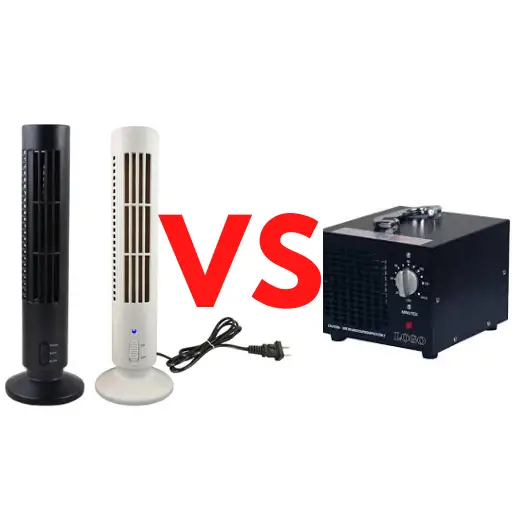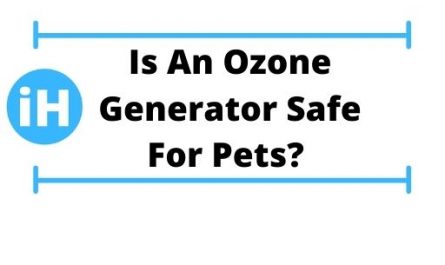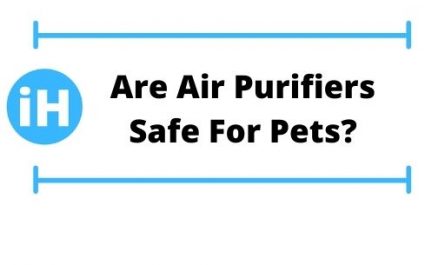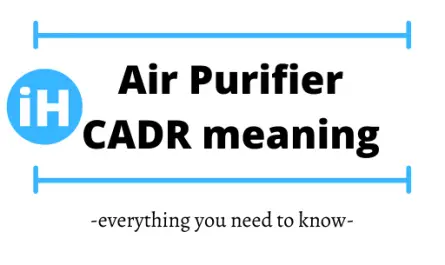Last updated on August 29th, 2021 at 10:31 am
Air ionizers and ozone generators are two popular ways of improving indoor air quality. They are both classified as air purifiers, with the same end goal in mind – purifying indoor air. While they do have some similarities, air ionizers are different than ozone generators in quite a few aspects. So, what is the difference between an air ionizer and ozone generator?
The difference better an air ionizer and ozone generator can be broken down into three categories: cleaning method, operating time, and cleaning effectiveness. In short, air ionizers use negative ions to clean the air, can be turned on all the time, and have the ability to remove all pollutants. On the other hand, ozone generators use ozone to clean the air, should be turned only in intervals, and are used mainly to remove odors and smells.
Clean air is very important in this day and age, especially indoors. According to the World Health Organization, indoor air pollution is one of the biggest reasons for premature deaths in the developed world. As a result, more and more people turn to different types of air purifiers to solve this problem. Air ionizers and ozone generators (also called ozonators) are two great solutions that we use for air cleaning. They both work best as a stand-alone unit, although you can find them as addons on other types of air purifiers.
In the next few sections, I am going to be going over each one of these aspects and explain them individually. So feel free to stick around for a more detailed answer to this commonly asked question.
Air ionizer vs ozone generator difference #1 Air cleaning method
The first big difference between an air ionizer and ozone generator is of course the way they clean the air.
Air ionizers do that by releasing a huge amount of negative ions out of the device and into the air. Negative ions are, as the name would suggest, negatively charged particles. In contrast, air pollutants / harmful particles are positively charged. As we already know from physics, opposites attract and negatives repel. In other words, negative ions and harmful particles attach themselves to each other in the air. When they do, the newly formed combined mass becomes quite heavy. So heavy, in fact, that gravity pulls it down to the ground. Once on the ground, this heavy combined mass can not rise back up in the air. Consequently, we can not inhale it into our lungs. Below is a simple 4-step presentation that summarizes how exactly negative ions clean the air.
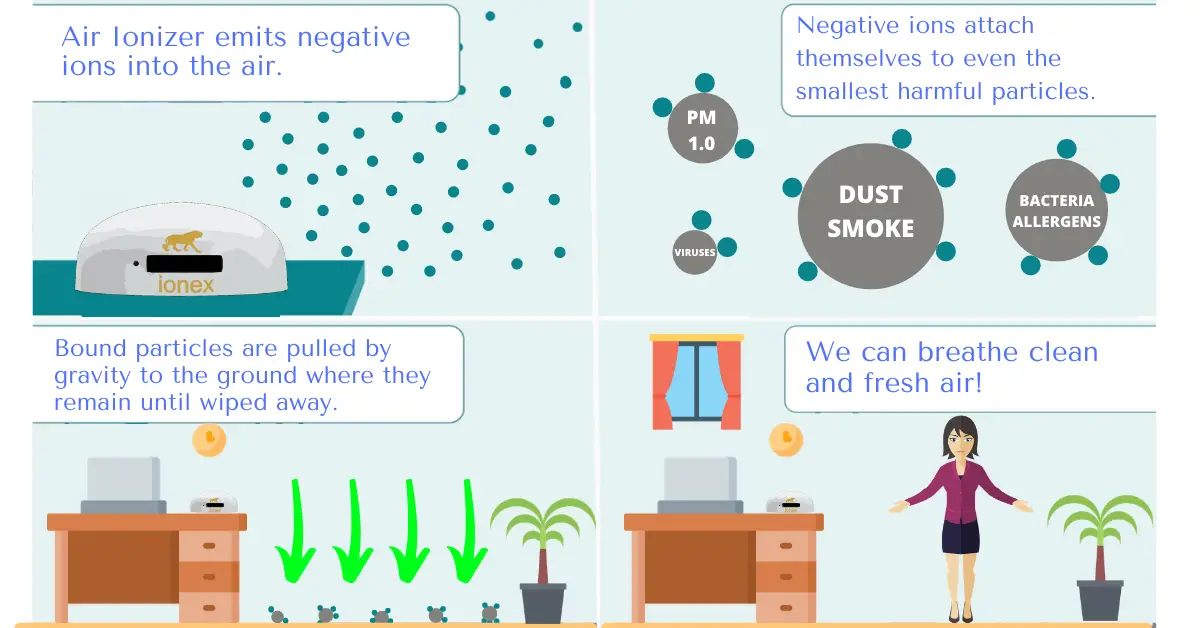
Source: ionex-ionizers.com
In contrast, ozone generators clean the air with ozone. The process is quite simple and goes like this. First, the ozone generator machine sucks in the ambient air around it. Once inside, a fan pushes this air further inside, where a high voltage mechanism and UV light transform oxygen into ozone. Lastly, ozone exits the device and is released into the air. Once in the air, ozone reacts with pollutants and harmful particles by breaking them down into simpler and less dangerous molecules. We call this process of ozone breakdown “oxidation”. Odixation is therefore a basis on which an ozone generator cleans the air. As I did with air ionizers, I am also including a picture of how an ozone generator works, down below.
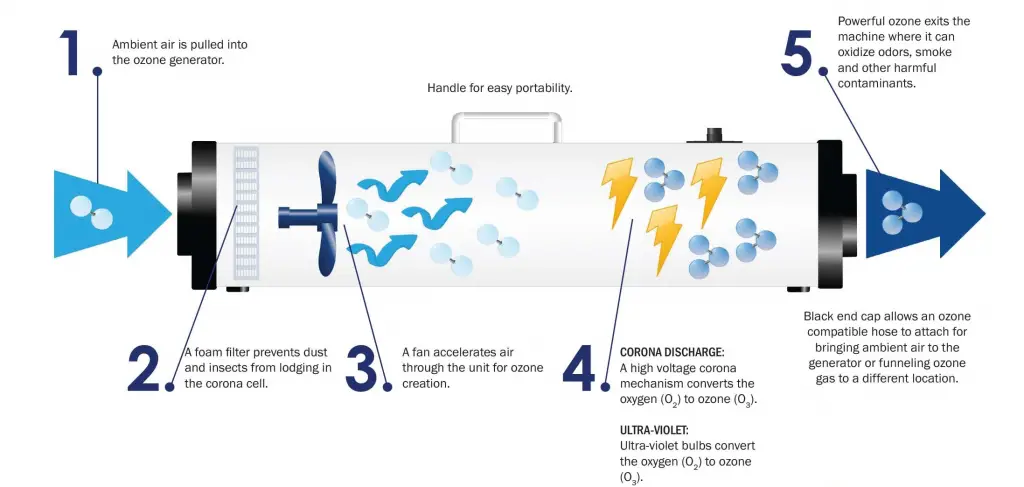
Source: zonesolutions.com/
Difference #2 Operating time
In order for you to fully understand this part, I need to do some explaining first. As you have just learned, negative ions and ozone molecules are two completely different things. Ozone generators release ozone, while air ionizers release negative ions. But there is a catch – air ionizers use different elements of ionization such as a steel needle, plasma, carbon, etc. I will not go into detail to avoid overcomplication, but most of these oxidize over time. From the paragraph above you already learned that oxidation goes hand in hand with ozone generators. What I am trying to say is that the majority of air ionizers release ozone as a byproduct. This information is key in order to understand the operating time difference between an air ionizer and ozone generator.
In general, air ionizers can be turned on 24/7, so you can use them without any breaks or restrictions. No restriction means that you can be in the room during the cleaning process, all the time. I always recommend having air ionizers plugged in and working as long as possible. This is because rooms in your house or flat are constantly getting a new supply of air, even if you have closed doors and windows. When you first put an air ionizer in a room, it usually needs a couple of hours to completely clean the air. After that, if you do not turn it off, it will clean any new polluted air as it comes into the room, without delays.
I did mention that the majority of air ionizers produce ozone as a byproduct. This is very important for anyone with respiratory issues. Ozone is bad for your health because irritates your respiratory system. It is even worse for anyone that has existing respiratory issues. So, if you are a heavy or moderate allergy sufferer or have asthma, keep your air ionizer at a distance, or have it turned on only when you are not in the room. Alternatively, you can get an air ionizer that produces no ozone – this way you will not have any limitations.
In contrast, you should run ozone generators only between 3 to 10 hours at a time. Duration depends on the room size – small rooms need less time to clean than larger rooms. The difference between ozone emission from ozone generator and air ionizer is huge. Ozone generators produce much more ozone. I have already explained that ozone is harmful – even in small quantities, but especially so in large. This is why you should run an ozone generator in an empty room only (meaning no people or animals). Otherwise, you risk some potentially serious health complications, especially in connection with your respiratory system. Also, once you turn off the device you still need to wait for up to 4 hours for ozone to completely disappear.
Difference #3 Which pollutants it removes.
The last difference between air ionizers and ozone generators is which pollutants they remove from the air.
Air ionizers can remove harmful particles of any size, which is great. Negative ions can attach themselves to harmful particles as small as 0.01 microns. This is why many people choose air ionizers for their superior cleaning abilities. They can remove even viruses and bacteria, which other air purifiers struggle to remove due to a very small size. For reference I have prepared a table of different particles and their size, so you can get an idea of how big common air pollutants actually are.
Common Indoor Pollutant | Particles Size in Microns |
Pollen, mold and plant spores | 7-70 |
Dust mites | 3-10 |
Hairspray | 3-10 |
Large bacteria | 1-20 |
Lead dust | 1-3 |
Auto emissions | 1-3 |
Fungal spores | 0.5-7 |
Cooking odors | 0.3-1 |
Dust | 0.2-8 |
Pet dander | 0.15-8 |
Small bacteria | 0.08-1 |
Tobacco smoke | 0.008-0.6 |
Viruses | 0.005-0.001 |
VOC (volatile organic compounds) | Less than 0.001 |
Ozone generators are mostly used to remove smells and odors, as they can not effectively remove biological pollutants (mold, viruses, and bacteria). They also do not efficiently remove particulate matter (PM), such as dust, pollen, and other allergens. This is why an ozone generator is not a very effective tool for anyone looking to get rid of allergies or other respiratory issues. As the name already suggests, ozone generators do mainly one thing – effectively removing any types of smells and odors, especially cigarette smoke. And they do this one thing very well. Important note: after ozone removes the smell, you still have to destroy the source, otherwise the smell will eventually return!
Choosing between an Ozone generator and Air Ionizer
So far you have learned the difference between an ozone generator and air ionizer. The next step is to determine which one is more suitable for your needs. Each of these two devices fulfill very different roles, and they do it in a different way.
If you are looking for a solution to get rid of strong odors or smells, then an ozone generator will fit you better than an air ionizer. Otherwise, an air ionizer is the way to go in pretty much every other aspect. Always keep in mind that ozone is harmful to your lungs, even in smaller quantities. Therefore, if you are looking for an air purifier and decide to go with an air ionizer…try to choose a model that does not emit any ozone! This way you will get to enjoy the benefits of clean air, without worries about your health.
And there you have it. Now you know that the difference between air ionizer and ozone generator boils down to the air cleaning method, operating time, and type of pollutants they remove. In this regard, air ionizers are overall superior cleaning devices that use negative ions to remove all air pollutants, regardless of size. Air ionizers can run all day and come without any other restrictions. In contrast, ozone generators work best for removing any type of odor or smell. They use large concentrations of ozone to achieve this and since ozone is harmful, you should not stay in the same room while the device is turned on. The purification process can last up to 10 hours, which depends mainly on the room size.
Related posts:
I hope you found this article useful and got all the information you needed. For any questions comment below!
